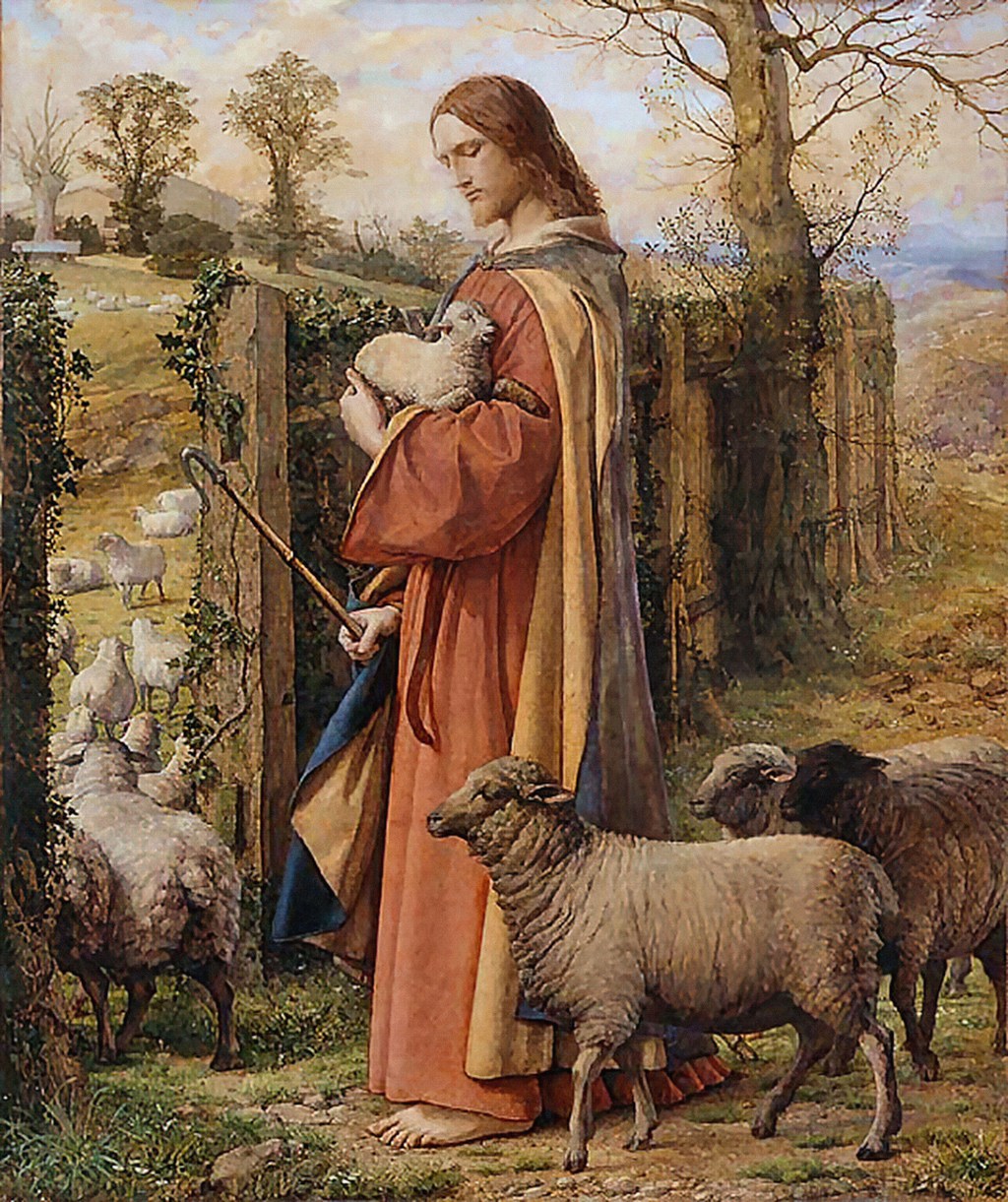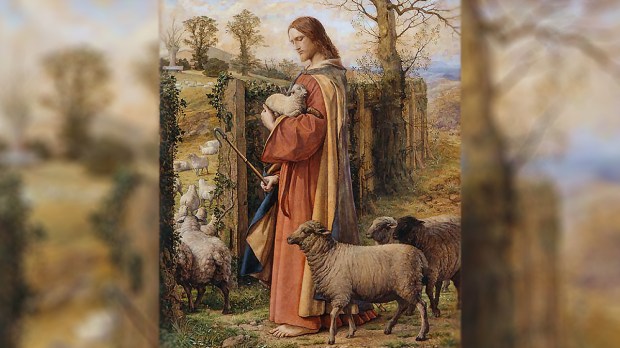Each year the Church observes the Fourth Sunday of Easter as Good Shepherd Sunday. The Gospel for Mass is drawn from the tenth chapter of the Gospel of John. A painting by 19th-century Scottish painter William Dyce (+1864), The Good Shepherd, draws our attention to three things about Jesus the Good Shepherd.

The Lamb of God
In his sumptuous, wide-sleeved tunic and jewel-clasped, gold-lined cloak, Christ seems more a regal prince than a lowly sheepkeeper. His face is rapt in tenderness gazing at the once-lost sheep nestled in his arms — just minutes after being snatched from its demise by way of that hooked crook.
Dyce portrays in paint what St. Teresa Benedicta of the Cross (Edith Stein) captured in poetry:
The Good Shepherd goes silently through the lands.
Now and then he gathers from the depths of the abyss
a little lamb, shelters it at his heart.
And then others always follow him.
Especially at this particular moment in history, such compassion is something the world needs desperately. Pope St. John Paul II stressed this:
People need to come out of their anonymity and fear. They need to be known and called by name, to walk in safety along the paths of life, to be found again if they have become lost, to be loved, to receive salvation as the supreme gift of God’s love. All this is done by Jesus, the Good Shepherd.
St. Claude la Colombière offers a riveting reflection on the mercy of Jesus the Good Shepherd:
What does amaze me is that God should be so affected when we stray. He knows quite well that we are nothing, and suffers no real loss when we break away from him. Yet he shows profound grief at our separation and makes every effort to win us back.
Imagine the desolation of the poor shepherd whose sheep has gone astray. The entire countryside resounds with the cries of the unfortunate man; neglecting the rest of his flock, he runs through woods and over hills, combing thickets and undergrowth, lamenting and shouting at the top of his voice. He cannot bring himself to give up until he has found his lost sheep and brought it back to the fold. That is how the Son of God acted. When disobedient humanity had escaped from the creator’s guidance, the Son of God came down to earth and spared neither toil nor trouble to restore us to the position from which we had fallen.
He still does the same thing daily for those who have strayed from him through sin. He follows their trail, so to speak, calling them again and again until he succeeds in getting them back on the road to salvation. It is he who must make all the advances, who must offer us his grace, pursue us and beg us to take pity on ourselves; otherwise we should never think of asking him for mercy.
Dyce’s depiction of the Good Shepherd radiates his incomparable kindness and gentleness, drawing us in like those content sheep clinging close to Christ.
In The Good Shepherd, as Jesus looks intently at the rescued lamb, he is pondering something else as well: how much it reminds him of him. Jesus is the Lamb of God who is to be sacrificed to take away the sins of the world.
Pope Benedict XVI commented on this:
In the Ancient Near East, it was customary for kings to style themselves shepherds of their people. This was an image of their power, a cynical image: to them their subjects were like sheep, which the shepherd could dispose of as he wished. When the shepherd of all humanity, the living God, himself became a lamb, he stood on the side of the lambs, with those who are downtrodden and killed. This is how he reveals himself to be the true shepherd: I am the Good Shepherd … I lay down my life for the sheep, Jesus says of himself (Jn 10:14). It is not power but love that redeems us! This is God’s sign: He himself is love.
The Gate
The other main character of Dyce’s The Good Shepherd besides Jesus himself is the open doorway to the sheepfold. Jesus says in John:
I am the sheepgate. … I am the gate. Whoever enters through me will be safe. He will go in and out and find pasture. … Whoever does not enter the sheepfold through the gate but climbs in some other way is a thief and a marauder. The one who enters through the gate is the shepherd of the sheep; the keeper opens the gate for him (Jn 10:8-9, 2-3).
A door serves two purposes: It acts as a barrier that provides protection and it is a threshold that enables access. In Jesus the Good Shepherd we find the protection we need from the evils and assaults of the world. A shepherd in the time of Christ would sleep at night across the doorway of the enclosure, using his body as a barricade to protect the sheep within from any attack of wolves. Christ the Good Shepherd longs to be this for us his flock. As St. Thomas Aquinas writes:
The door safeguards the sheep by keeping those within from going out, and by protecting them from strangers who want to come in. And this applies to Christ, for he is our safeguard and protection.
And a door is a literal go-between by which one is granted entry to an interior. In the case of Christ the Gate, he personally shepherds us to greater intimacy with himself. Again quoting St. Thomas:
Now the purpose of a door is to conduct one into the inner rooms of a house, and this is fitting to Christ, for one must enter into the secrets of God through him.
Jesus calls himself the gate, the door as an invitation, wooing us to “enter in” to life and closeness with him. Nothing is more vital than this unity. “Christ is the door; he is the way; he is the bridge. In him the connection is made between the divine and the human. Union with him is the possession of God for one’s own” (Antonin Sertillanges). To drive home this point, look at how William Dyce has adorned the door: The gate is draped and laced with a climbing vine. Jesus will tell his disciples a little later: I am the vine, you are the branches. He who lives in me and I in him will produce abundantly, for apart from me you can do nothing (Jn 15:5).
God reveals to St. Catherine of Siena:
This is why eternal Truth said, “I say that no one can come to me except by means of my Only-Begotten Son; for he is the one who made the way you must follow. He is way, truth, and life. They have reached the gate of truth and passed through it to find themselves in the peaceful sea with those who are truly joyful.”
“Through Jesus’ merciful heart, as through an open gate, we pass through to heaven” (St. Faustina). Which leads us to the third detail/mystery of the painting.
The Sheepfold
As you peer at the background of the painting, don’t you feel a yen to join that “peaceful sea” of seven reclining sheep chilling in the sunlit grass? They’re probably saying to each other, This is awesome!We should really compose a psalm about this! “The Lord is my shepherd; there is nothing I shall want. In verdant pastures he gives me repose.”
But isn’t there something odd about the scenery of this painting? The landscape and buildings don’t look like any pictures of the Holy Land we remember, and the canvas exudes a more modern feel than ancient. The painter employs the device of anachronism to illustrate more fully his message. According to the analysis of one art historian:
Dyce placed the traditional figure of Christ as the Good Shepherd in a setting that contemporary reviewers recognized as a “landscape with a sheepfold paled in trees and a cultivated country, such as might be seen in any rural district round London” (Art Journal, 1859).
For this is a Good Shepherd who continues to come to us today, in our own situation and circumstances, our world and our worries, ready to find us no matter how lost we may be, to lift us out of danger, hold us close to himself, and enfold us in a community of faith where we will be safe and will flourish in holiness. And as majestic as he may be in his attire, this Good Shepherd all the same remains barefooted. For, in his humility, he stands ready to be stripped of his kingly clothes and nailed to the cross.
We must never forget the price paid for the amazing privilege he bestows on us. St. Peter Chrysologus reminds us:
When the good Shepherd laid down his life for his sheep, he did not lose it. In this way he held his sheep; he did not abandon them. Indeed, he did not forsake them, but invited them. He called and led them through fields full of death, and a road of death, to life-giving pastures.
The perspective of the painting is important: Note that the Good Shepherd is not leading the sheep out — he is leading the sheep in. St. Thomas Aquinas imagines the Good Shepherd saying, “They follow me by walking the path of gentleness and innocence in this life, and I will see that afterwards they will follow me by entering into the joys of eternal life.” We are called to deepen our faithfulness to — and gratefulness for — the sheepfold of the Church — our community. It is a foreshadowing of our being together in the joy of heaven.
William Dyce’s awe-inspiring painting moves us to join St. Symeon the New Theologian (+1022) as he sings his praises of Jesus the Good Shepherd:
He extends to me his divine hand,
and lifts me out of the mud hole.
He thoroughly embraces me.
He throws Himself upon my neck.
Ah, how shall I bear these wonders!
And He kisses me over and over.
And He lifts me up on his shoulders,
me who had been so completely worn out
and had lost all my strength.
Ah me! how shall ever describe adequately these favors!
What love, what goodness!
And He leads me out of Hell,
out of that place and its darkness,
and leads me into another place,
whether it is still this world or up in the air someplace,
I really am not able to say.
This I know, that it is a light
and it carries me and sustains me
and leads me toward a great light.
~
Find Fr. Peter John Cameron’s reflection on the Sunday Gospel each week here.


